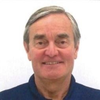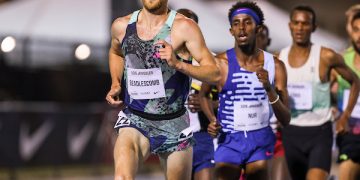RunBlogRun opines: This is part one of a two piece series on Clayton Murphy, the 2016 Rio Olympic bronze medalist at the 800 meters. In 2017, Clayton Murphy took on some new challenges, and it did not work out according to his plan. The evolution of a middle distance runner has its ups and downs. For Clayton Murphy, 2017 was, well, as David Hunter just described it, a roller coast year. This is David Hunter’s coverage of a surprising year of 2017 for Clayton Murphy.
 Clayton Murphy, photo by PhotoRun.net
Clayton Murphy, photo by PhotoRun.net
This is the first part of a two-part series on the topsy-turvy 2017 of America’s Olympic 800 meter bronze medalist.
December 8th, 2017
“You’ll never achieve what you never planned for.” – Collins Hasty
As the current year began and after 3 consecutive years of eye-popping middle distance progression, Olympic 800 meter bronze medalist Clayton Murphy looked forward to 2017 with optimism and ambition. “It was exciting to have a year like 2016 and view all the opportunities I had in front of me as well as the challenges we knew would be ahead,” states Murphy as he reflects on the beginning of this world championship year. “There was no ‘let’s see if we can mimic what we did the year before.’ It was, ‘let’s see if we can do better than we did the year before.’ That was exciting to me to have that challenge, to try to get better every year.”
Having signed with Nike just before the 2016 Olympic Trials, Murphy – a rising senior – faced the transition from collegiate athlete to track & field professional. “It was a pretty easy adjustment – keeping the same coach [Lee Labadie], keeping the same environment [the University of Akron]. The training was familiar for me. I was still going to class [to finish my degree…]. The only difference was approaching different meets and workouts not really matching up with the guys. But those two transitions weren’t anything I couldn’t deal with. I worked out and ran with the guys when I could. Coach and I went together to the meets that mattered when we could. There wasn’t a whole lot of shock like a new school, a different training environment, or having to move. It was a very easy thing.”
As the new year began, the former Zip star opened up at New York’s Armory, racing there for the first time and competing in the Millrose Games’ Wanamaker Mile. “It is a meet and a race like no other. I was trying to not let it get to me and just trying to enjoy the moment,” explains Murphy, who set two indoor PR’s in the race [hitting 1500 meters in 3:39.25 and finishing the mile in 3:54.31] closing from way off the pace over the final two laps to finish second to Eric Jenkins. “After the race, I knew I left too much work for the end. It was only my second indoor mile on a banked track. Being used to running on a 300 meter track, it was a big difference for me. On a 300 meter track, you have more opportunities to make up ground. When you are on a banked track racing the best guys in the U.S. and the world, it is much more difficult to make up ground. That was a big lesson for me to be closer to the front. There was nothing to hang my head about. It was just a big learning moment for me.”
The Millrose lesson was not lost on the young middle distance star. Two weeks later, at the USATF Indoor Championships in Albuquerque, Murphy authored a tactical gem in the final of the 1000 meter championship race to capture the indoor crown. Ceding the early lead to Andrew Wheating, Murphy stayed right on the former Olympian’s shoulder until uncorking a blistering kick over the final 250 meters to easily pull away for the win. “I did everything I wanted to in every aspect of the race: getting out in 2nd place and, whatever the pace was, running in 2nd place,” offered Murphy. Despite competing in the rarified air of the high plains, the new indoor champion posted a PR winning time [2:18.60] which would prove to be the year’s world indoor leader.
After a winter season spiced with personal bests and also an important indoor racing lesson, Murphy was eager to test himself on the big outdoor oval. At April’s Mt. SAC Relays, the Nike athlete kicked off his outdoor season with an impressive 800 meter win over Erik Sowinski, the reigning indoor national 800 meter champion. “They didn’t have any pacers. Erik took the pace out for the first 550 meters. I went through [the 400] in 51 flat and I was on Erik’s shoulder,” recalls Murphy. “At 550 meters, I passed Erik on the backstretch and kept going. I was very much alone the final 100 meters.” While the victory was impressive, it was Murphy’s clocking that grabbed everyone’s attention: his winning mark of 1:43.60 was the fastest 800 meter time ever posted in April, a performance that would ultimately rank #3 on the 2017 world list. “I think I was more surprised [with the Mt. SAC clocking] than Lee was. It got me excited about the next upcoming races.”
The timing of the Mt. SAC breakthrough fit nicely with the covert racing plans that Murphy and Labadie had concocted months before: the quest for a successful 800m/1500m double at the USATF outdoor nationals. The reigning Olympic 800 meter bronze medalist charts out the idea’s evolution. “We wanted to attempt in the fall after Rio. The decision to actually do it occurred in January, February when we set our minds and laid out our plans to get ready to do it,” reveals Murphy. “We planned out the season to do the double and we planned all of our training and meets to get ready to do it. And if it came to the point that I only wanted to do one, then it’s not like I’d have trained for the wrong event.”
The undisclosed plan to attempt to qualify for the World Championships in two middle distance events dominated every aspect of Murphy’s 2017 preparation and racing. After posting the early-season 800 meter world leader in Walnut, California, Murphy played a pivotal role for Team USA at the World Relays where his gutty anchor leg [1:49.18] secured a narrow victory for the Yanks; and he then raced a quick turn-around in Des Moines running the USATF 1 Mile Road Championship Race [3:59] and then the elite Drake Relays 1500 meters race [3:41.75] two days later – winning both. And then it was back to work for a solid month of focused training leading up to the Diamond League’s Prefontaine Classic.
At Pre, with Olympic gold medalist Matthew Centrowitz a late Bowerman Mile scratch, Murphy would nonetheless face what turned out to be the most impressive mile field of the year. The young American was ready – but so were his competitors. The mile was won by Ronald Kwemoi who clocked a world-leading 3:49.06 as he led a total of 25 milers across the line in under 4:00. Murphy would finish 5th in 3:51.99, setting yet another PR and ringing up a time which would end the year as tied for #5 on the world list, bettered only by the 4 Kenyans who defeated him that day. For Clayton and his coach – the only two aware of Murphy’s undisclosed plans to run two events at Nationals – the young athlete’s performance demonstrated that plans for the middle distance double were right on track.
After Pre, the duo’s training regimen continued and included simulation of the rigorous racing schedule Murphy would face in Sacramento. “Oh yeah, no rock remains unturned between the two of us,” laughs Murphy as he addresses the twosome’s thoroughness in preparation. “The weather for sure was early on the radar. I did everything you could possibly do: hydration; sleep; working out in the heat of the day; working out at the times the races were going to be run. I was on the west coast already, so I just knew when the races were going to be run. So I just got the times and ran at those times. I was running two times a day at the times I would run those preliminary rounds. I was doing anything possibly I could do to wake my body up at the right time of day, to eat the meal the same time during workouts, to mimic when I was going to eat before and after a race. I did everything you could possibly do.”
There was still time in mid-June for a frolic as the Sacramento date with destiny loomed closer. In a post-NCAA twilight meet at Lewis & Clark College just outside of Portland, a select field with a carefully-scripted race plan would work to set up Clayton Murphy for an attempt to take down the 42-year-old American 1000 meter record of 2:13.9 held by Rick Wohlhuter. In a carnival atmosphere as shadows lengthened, fans entered onto the track and encircled the oval as the race got underway. While unsteady pacing doomed the record attempt after a single lap, Murphy nonetheless sped along unaided to win the race in 2:17.17 – a noble effort that remains #1 on the 2017 world list. The 800m/1500m attempt was still on. And Clayton authorized me to release my story on his news-breaking plans for the middle distance double.
Next up: The Part Two Conclusion: Calamity At Nationals And The Restoration That Followed
Author

Dave Hunter is an award-winning journalist who is a U.S. Correspondent for Track & Field News. He also writes a weekly column and serves as Senior Writer for www.RunBlogRun.com, and covers championship track & field competition domestically and in such global capitals as Moscow, Birmingham, Zurich, Brussels, Beijing, Rio de Janeiro, Zagreb, Ostrava, and Doha. Hunter frequently serves as the arena or stadium announcer for championship track & field gatherings, including the Ivy League, the Big East, the Mid-American Conference, the NAIA, the Big Ten, and the Millrose Games. Hunter has undertaken foreign and domestic broadcast assignments. He ran his marathon P.R. 2:31:40 on the Boston Marathon course back in the Paleozoic Era. To find out more about Dave, visit his website: www.trackandfieldhunter.com He can be reached at: dave@trackandfieldhunter.com
View all posts




















